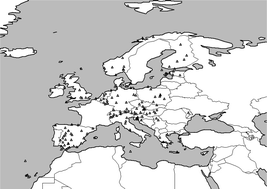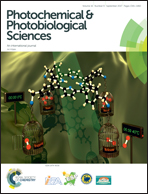UV Index monitoring in Europe
 *a
Julian
Gröbner,b
Mario
Blumthaler,c
Barbara
Klotz,c
Hugo
De Backer,
*a
Julian
Gröbner,b
Mario
Blumthaler,c
Barbara
Klotz,c
Hugo
De Backer,  d
David
Bolsée,e
Rolf
Werner,f
Davor
Tomsic,g
Ladislav
Metelka,h
Paul
Eriksen,i
Nis
Jepsen,i
Margit
Aun,j
Anu
Heikkilä,k
Thierry
Duprat,l
Henner
Sandmann,m
Tilman
Weiss,n
Alkis
Bais,o
Zoltan
Toth,p
Anna-Maria
Siani,q
Luisa
Vaccaro,r
Henri
Diémoz,s
Daniele
Grifoni,t
Gaetano
Zipoli,u
Giuseppe
Lorenzetto,v
Boyan H.
Petkov,w
Alcide Giorgio
di Sarra,x
Francis
Massen,y
Charles
Yousif,z
Alexandr A.
Aculinin,aa
Peter
den Outer,ab
Tove
Svendby,ac
Arne
Dahlback,ad
Bjørn
Johnsen,
d
David
Bolsée,e
Rolf
Werner,f
Davor
Tomsic,g
Ladislav
Metelka,h
Paul
Eriksen,i
Nis
Jepsen,i
Margit
Aun,j
Anu
Heikkilä,k
Thierry
Duprat,l
Henner
Sandmann,m
Tilman
Weiss,n
Alkis
Bais,o
Zoltan
Toth,p
Anna-Maria
Siani,q
Luisa
Vaccaro,r
Henri
Diémoz,s
Daniele
Grifoni,t
Gaetano
Zipoli,u
Giuseppe
Lorenzetto,v
Boyan H.
Petkov,w
Alcide Giorgio
di Sarra,x
Francis
Massen,y
Charles
Yousif,z
Alexandr A.
Aculinin,aa
Peter
den Outer,ab
Tove
Svendby,ac
Arne
Dahlback,ad
Bjørn
Johnsen,  ae
Julita
Biszczuk-Jakubowska,af
Janusz
Krzyscin,ag
Diamantino
Henriques,ah
Natalia
Chubarova,ai
Predrag
Kolarž,aj
Zoran
Mijatovic,ak
Drago
Groselj,al
Anna
Pribullova,am
Juan Ramon Moreta
Gonzales,an
Julia
Bilbao,ao
José Manuel Vilaplana
Guerrero,
ae
Julita
Biszczuk-Jakubowska,af
Janusz
Krzyscin,ag
Diamantino
Henriques,ah
Natalia
Chubarova,ai
Predrag
Kolarž,aj
Zoran
Mijatovic,ak
Drago
Groselj,al
Anna
Pribullova,am
Juan Ramon Moreta
Gonzales,an
Julia
Bilbao,ao
José Manuel Vilaplana
Guerrero,  ap
Antonio
Serrano,
ap
Antonio
Serrano,  aq
Sandra
Andersson,ar
Laurent
Vuilleumier,
aq
Sandra
Andersson,ar
Laurent
Vuilleumier,  as
Ann
Webb
as
Ann
Webb  at
and
John
O'Haganau
at
and
John
O'Haganau
* Corresponding authors
a
University of Veterinary Medicine, Unit of Physiology and Biophysics, Vienna, Austria
E-mail:
alois.schmalwieser@vetmeduni.ac.at
b PMOD/WRC, Davos Dorf, Switzerland
c Medical Univ. Innsbruck, Innsbruck, Austria
d Royal Meteorological Institute of Belgium, Observations, Brussels, Belgium
e Royal Belgian Institute for Space Aeronomy, Brussels, Belgium
f Bulgarian Academy of Sciences, Stara Zagora, Bulgaria
g Metorological and hydrological institute of Croatia, Metorological and hydrological institute of Croati, Croatia
h Czech Hydrometeorological Institute, Solar and Ozone Department, Hradec Kralove, Czech Republic
i Danish Meteorological Institute, Copenhagen, Denmark
j Tartu Observatory, Tartumaa, Estonia
k Finnish Meteorological Institute, Helsinki, Finland
l Météo-France, Toulouse Cedex, France
m Bundesamt fur Strahlenschutz Neuherberg, Section for Optical Radiation, Neuherberg, Germany
n sglux GmbH, Berlin, Germany
o Aristotle University of Thessaloniki, Greece
p Hungarian Meteorological Service, Marczell György Main Observatory, Budapest, Hungary
q Sapienza Universita’ di Roma, Physics Department, Rome, Italy
r ISPRA, Physical Agents Unit, Rome, Italy
s ARPA Valle d'Aosta loc, Saint-Christophe, Italy
t LaMMA Consortium, Institute of Biometeorology of the National Research Council, Sesto Fiorentino, Italy
u CNR-IBIMET, Florence, Italy
v ARPA di Vicenza, Vicenza, Italy
w National Research Council, Institute of Atmospheric Sciences and Climate, Bologna, Italy
x ENEA, Laboratory for Observations and Analyses of the Earth and Climate, Rome, Italy
y Lycée Classique de Diekirch, Computarium and meteoLCD, Diekirch, Luxembourg
z University of Malta, Institute for Sustainable Energy, Marsaxlokk, Malta
aa Institute of Applied Physics of the Academy of Sciences of Moldova, Kishinev, Moldova (the Republic of)
ab Dutch National Health Institute (RIVM), Netherlands
ac NILU – Norwegian Institute for Air Research, Kjeller, Norway
ad University of Oslo, Institute of Physics, Oslo, Norway
ae Statens Stralevern, Monitoring and Research, Oesteras, Norway
af Institute of Meteorology and Water Management, Gdynia, Poland
ag Institute of Geophysics, Polish Academy of Sciences, Warszw, Poland
ah Instituto Português do Mar e da Atmosfera, Observatório Afonso Chaves, Ponta Delgada S. Miguel, Portugal
ai Moscow State University, Moscow, Russian Federation
aj University of Belgrade, Zemun, Serbia
ak University of Novi Sad, Novi Sad, Serbia
al Slovenian Environment Agency, Ljubljana, Slovenia
am Slovakian Academy of Sciences, Tatranska Lomnica, Slovakia
an Spanish Meteorological Agency, Area of Atmospheric Observation Networks, Madrid, Spain
ao University of Valladolid, Valladolid, Spain
ap National Institute for Aerospace Technology, Mazagon, Spain
aq University of Extremadura, Department of Physics, Badajoz, Spain
ar SMHI, Norköpping, Sweden
as MeteoSwiss, Atmospheric data division, Payerne, Switzerland
at University of Manchester, Manchester, United Kingdom of Great Britain and Northern Ireland
au Public Health England Centre for Radiation Chemical and Environmental Hazards, Radiation Dosimetry, Didcot, United Kingdom of Great Britain and Northern Ireland
Abstract
The UV Index was established more than 20 years ago as a tool for sun protection and health care. Shortly after its introduction, UV Index monitoring started in several countries either by newly acquired instruments or by converting measurements from existing instruments into the UV Index. The number of stations and networks has increased over the years. Currently, 160 stations in 25 European countries deliver online values to the public via the Internet. In this paper an overview of these UV Index monitoring sites in Europe is given. The overview includes instruments as well as quality assurance and quality control procedures. Furthermore, some examples are given about how UV Index values are presented to the public. Through these efforts, 57% of the European population is supplied with high quality information, enabling them to adapt behaviour. Although health care, including skin cancer prevention, is cost-effective, a proportion of the European population still doesn't have access to UV Index information.

 Please wait while we load your content...
Something went wrong. Try again?
Please wait while we load your content...
Something went wrong. Try again?
